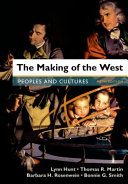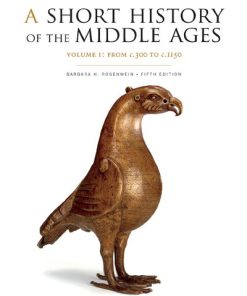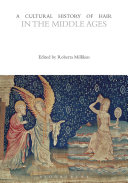A Short History of the Middle Ages 5th Edition by Barbara H Rosenwein ISBN 9781442636231 1442636238
$50.00 Original price was: $50.00.$25.00Current price is: $25.00.
A Short History of the Middle Ages 5th Edition by Barbara H Rosenwein – Ebook PDF Instant Download/Delivery: 9781442636231 ,1442636238
Full download A Short History of the Middle Ages 5th Edition after payment

Product details:
ISBN 10: 1442636238
ISBN 13: 9781442636231
Author: Barbara H Rosenwein
A Short History of the Middle Ages 5th Edition Table of contents:
The Medieval World Today
1.1 The Roman Empire, c.300
1.2 The Capital Cities of the Empire
1.3 Christian Populations at the End of the 3rd cent
1.4 Wijster
1.5 The Huns and the Visigoths, c.375–450
1.6 The Former Western Empire, c.500
1.7 Tours, c.600
1.8 Europe, the Eastern Roman Empire, and Persia, c.600
2.1 Persian Expansion, 602–622
2.2 The Byzantine Empire, c.700
2.3 The Islamic World to 750
2.4 Western Europe, c.750
2.5 Lombard Italy, c.750
3.1 The Byzantine and Bulgarian Empires, c.920
3.2 The Avar Khaganate, 7th–8th cent
3.3 The Islamic World, c.800
3.4 Europe, c.814
3.5a Partition of 843 (Treaty of Verdun)
3.5b Partition of 870 (Treaty of Meerssen)
3.5c Partition of 880
3.6 Northern Emporia in the Carolingian Age
4.1 Constantinople, c.1100
4.2 The Byzantine Empire during the Reign of Basil II, 976–1025
4.3 Kievan Rus’, c.1050
4.4 Fragmentation of the Islamic World, c.1000
4.5 Viking, Muslim, and Hungarian Invasions, 9th and 10th cent
4.6 Europe, c.1050
4.7 Ottonian Empire, c.1000
5.1 The Byzantine and Seljuk Empires, c.1090
5.2 The Almoravid Empire, c.1115
5.3 Byzantium, 12th cent
5.4 Tours c.600 vs. Tours c.1100
5.5 Western Europe, c.1100
5.6 The First Crusade and Early Crusader States
5.7 The Norman Invasion of England, 1066–1100
5.8 The Iberian Peninsula, c.1140
6.1 Saladin’s Empire, c.1200
6.2 The Almohad Empire, c.1172
6.3 The Latin Empire and Byzantine Successor States, 1204– c.1250
6.4 The Angevin and Capetian Realms in the Late 12th cent.
6.5 Spain and Portugal, c.1275
6.6 Italy and Southern Germany in the Age of Frederick Barbarossa
6.7 France, c.1230
6.8 German Settlement in the Baltic Sea Region, 12th to 14th cent
7.1 The Mongol Empire, c.1260–1350
7.2 The Mamluk Sultanate
7.3a, b European and Eurasian Trade Routes, c.1300
7.4 Piacenza, Late 13th cent
7.5 Western Europe, c.1300
7.6 East Central Europe, c.1300
7.7 The Village of Toury, 14th and 15th cent
8.1 Eurasia c.1400
8.2 The First Phase of the Hundred Years’ War, 1337–1360
8.3 English and Burgundian Hegemony in France, c.1430
8.4 The Duchy of Burgundy, 1363–1477
8.5 Western Europe, c.1450
8.6 Long-Distance Sea Voyages of the 15th cent
List of Plates
1.1 Mars and Venus, Pompeii (1st cent.)
1.2 Hercules in the Garden of the Hesperides, Oplontis ( c.10–1 BCE)
1.3 Harbor Scene (late 1st cent. BCE)
1.4 Euhodus Sarcophagus ( c.161–170)
1.5 Venus and Two Nymphs, Britain (2nd or early 3rd cent.)
1.6 Tombstone, near Carthage (2nd cent.?)
1.7 Embracing Tetrarchs ( c.300)
1.8 Base of the Hippodrome Obelisk ( c.390)
1.9 Orant Fresco (second half of 4th cent.)
1.10 Sarcophagus of Junius Bassus (359)
1.11 Reliquary of Theuderic (late 7th cent.)
1.12 San Vitale, Ravenna, Apse Mosaics (mid-6th cent.)
2.1 Cross at Hagia Sophia (orig. mosaic 6th cent.; redone 768/769)
2.2 Page from an Early Qur’an (568–645)
2.3 Damascus Great Mosque Mosaic (706)
2.4 Great Square-Headed Brooch (early 6th cent.)
2.5 Saint Luke, Lindisfarne Gospels (first third of 8th cent.?)
2.6 Carpet Page, Lindisfarne Gospels (first third of 8th cent.?)
2.7 First Text Page, Gospel of Saint Luke, Lindisfarne Gospels (first third of 8th cent.?)
2.8 The Altar of Ratchis (737–744)
2.9 The Cividale Tempietto (8th cent.?)
MATERIAL CULTURE: FORGING MEDIEVAL SWORDS
2.10 The Sigurd Portal, Hylestad Stave Church, Norway (12th–13th cent.)
2.11 Ulfberht Sword (9th cent.)
2.12 The Utrecht Psalter (first half of 9th cent.)
3.1 Christ on the Cross amid Saints (9th–early 10th cent.)
3.2 Gregory of Nazianzus Preaches on the Plague of Hail, Gregory’s Homilies (c.880)
3.3 Water Pitcher in the Shape of an Eagle (796–797)
3.4 Chest or Cenotaph Panel (second half of 8th cent.)
3.5 Great Mosque, Córdoba (785–787)
3.6 Sacramentary of Saint-Germain-des-Prés (early 9th cent.)
3.7 Andromeda (840s?)
3.8 Psalter Page (second quarter of 9th cent.)
3.9 Saint John (second half of 9th cent.)
4.1 Emperor Basil II (1018)
4.2 Golden Jug (985–998)
4.3 The mihrab of al-Azhar Mosque (969/973)
4.4 Fatimid Cemetery at Aswan (11th cent.)
4.5 Oseberg Ship (834)
4.6 The Raising of Lazarus, Egbert Codex (985–990)
4.7 Christ Asleep, Hitda Gospels (c.1000–c.1020)
4.8 Saint Luke, Gospel Book of Otto III (998–1001)
MATERIAL CULTURE: THE MAKING OF AN ILLUMINATED MANUSCRIPT
4.9 Hamburg Bible (1255)
4.10 Miniature of Saint Dunstan (12th cent.)
4.11 Codex Aureus (870)
5.1 Isfahan Mosque Courtyard (11th–12th cent.)
5.2 Isfahan Mosque North Dome (1088)
5.3 Great Mosque Minaret at Siirt (1128/1129?)
5.4 Great Mosque at Diyarbakir (1179/1180?)
5.5 Almería Silk (first half of 12th cent.)
5.6 Durham Cathedral, Interior (1093–1133)
5.7 Sant Tomàs de Fluvià, The Last Supper, Painted Vault (early 12th cent.)
5.8 Cathedral Complex, Pisa (11th–12th cent.)
5.9 Saint-Lazare of Autun, Nave (1120–1146)
5.10 Autun, Cockfight (12th cent.)
5.11 Carthusian Diurnal from Lyon (12th cent.)
5.12 Sénanque Monastery Church, Interior (c.1160)
5.13 Jael, Humility, and Judith ( c.1140)
6.1 Frontispiece for the Book of Songs (1217–1219)
6.2 Funerary Madrasa Complex of Nur al-Din at Damascus (1167–1168)
6.3 Minaret at Rabat ( c.1199)
6.4 Bust of Frederick Barbarossa (1165)
6.5 Notre Dame of Paris, Exterior (begun 1163)
6.6 Notre Dame of Paris, Interior (begun 1163)
6.7 San Francesco at Assisi (Upper Church; completed by 1253)
6.8 Bamberg Cathedral, Tympanum of “The Princes’ Door,” ( c.1230–1235)
7.1 Great Mongol Shahnama, “The Death of Alexander” (1330s)
7.2 Funerary Complex of Mamluk Emirs Salar and Sanjar al-Jawli, Cairo (1302–1304)
7.3 Jews in an English Exchequer Tax Receipt Roll (1233)
7.4 Chalice (c.1300)
7.5 A Shrine Madonna from the Rhineland (c.1300)
7.6 Page from a Book of Hours, Northern France or Flanders (early 14th cent.)
7.7 Tomb and Effigy of Robert d’Artois (1317)
7.8 The Motet Le premier jor de mai (c.1280)
7.9 Page from Giovanni d’Andrea, Summa on Engagements and Marriages and Lecture on the Tree of Consanguinity and Affinity (c.1315)
7.10 Sepulcher of Giovanni d’Andrea, Bologna (1348)
7.11 Giotto, Scrovegni Chapel, Padua (1304–1306)
7.12 Giotto, Lamentation of Christ, Scrovegni Chapel (1304–1306)
MATERIAL CULTURE: THE DEVELOPMENT OF ISLAMIC CERAMICS
7.13 Great Mosque mihrab, Kairouan, Tunisia (862–863)
7.14 Rooster Ewer, Kashan, Iran (1200–1220)
7.15 Bowl, Samarqand, Uzbekistan (c.1420–1450)
8.1 Costanzo da Ferrara, Portrait Medallion of Mehmed II (1470s)
8.2 Ushak Medallion Carpet, Anatolia (third quarter of 15th cent.)
8.3 Building Complex, Edirne (1484–1488)
8.4 Corpses Confront the Living (c.1441)
8.5 Donatello, Judith and Holofernes (c.1420–1430)
8.6 Piero di Cosimo, Venus, Cupid, and Mars (c.1495–1505)
8.7 Filippo Brunelleschi, Florence Cathedral Dome (1418–1436)
8.8 Leonardo da Vinci, The Last Supper (1494–1497)
8.9 Jacopo de’ Barbari, Bird’s-Eye View of Venice (1500)
8.10 History of Alexander the Great, Tapestry (c.1459)
8.11 Rogier van der Weyden, Columba Altarpiece (1450s)
8.12 Jan van Eyck, Portrait of Jan de Leeuw (1436)
List of Genealogies
2.1 Muhammad’s Relatives and Successors to 750
2.2 The Merovingians
3.1 The Abbasids
3.2 The Carolingians
4.1 Alfred and His Progeny
4.2 The Ottonians
5.1 The Great Seljuk Sultans
5.2 The Comnenian Dynasty
5.3 The Salian Kings and Emperors
5.4 The Norman Kings of England
5.5 The Capetian Kings of France
6.1 The Angevin Kings of England
6.2 Rulers of Germany and Sicily
7.1 The Mongol Khans
7.2 Henry III and His Progeny
7.3 Louis IX and His Progeny
8.1 Kings of France and England and the Dukes of Burgundy during the Hundred Years’ War
8.2 Yorkist and Lancastrian (Tudor) Kings
List of Figures
1.1 San Vitale, Ravenna, Reconstructed Original Ground Plan, 6th cent
2.1 Late Antique Ephesus
2.2 Yeavering, Northumberland, Anglo-Saxon Royal Estate, 7th cent
3.1 Mosque Plan (Cairo, Ibn Tulum Mosque, built 876–879)
5.1 Saint-Germain of Auxerre (12th cent.)
5.2 A Model Romanesque Church: Saint-Lazare of Autun
5.3 Plan of Fountains Abbey (founded 1132)
6.1 Elements of a Gothic Church
7.1 Single Notes and Values of Franconian Notation
Abbreviations, Date Conventions, Website
Acknowledgments
CHAPTER ONE: Prelude: The Roman World Transformed (c.300–c.600)
Part I: Three Cultures from One
CHAPTER TWO: The Emergence of Sibling Cultures (c.600–c.750)
MATERIAL CULTURE: FORGING MEDIEVAL SWORDS
CHAPTER THREE: Creating New Identities (c.750–c.900)
CHAPTER FOUR: Political Communities Reordered (c.900–c.1050)
MATERIAL CULTURE: THE MAKING OF AN ILLUMINATED MANUSCRIPT
Part II: Diverging Paths
CHAPTER FIVE: New Configurations (c.1050–c.1150)
CHAPTER SIX: Institutionalizing Aspirations (c.1150–c.1250)
CHAPTER SEVEN: Tensions and Reconciliations (c.1250–c.1350)
MATERIAL CULTURE: THE DEVELOPMENT OF ISLAMIC CERAMICS
CHAPTER EIGHT: Catastrophe and Creativity (c.1350–c.1500)
People also search for A Short History of the Middle Ages 5th Edition:
a short history of the middle ages sixth edition pdf
a short history of the middle ages samenvatting
samenvatting a short history of the middle ages
short history of the middle ages
what does medieval mean in history
You may also like…
Uncategorized
Uncategorized
A Short History of the Middle Ages Volume I From c 300 to c 1150 6th Edition Barbara Rosenwein
History - Ancient History
History - Middle Eastern History
A Short History of the Middle Ages Volume 2 c900 c1500 Barbara H. Rosenwein
History - European History
Politics & Philosophy - Anthropology
A Short History of the Middle Ages Volume II From c 900 to c 1500 5th Edition Rosenwein
Politics & Philosophy - Anthropology
A Short History of the Middle Ages Volume I From c 300 to c 1150 5th Edition Rosenwein
Education Studies & Teaching - Educational Theory
Rewriting History in the Central Middle Ages 900 1300 1st Edition Emily A. Winkler (Editor)











